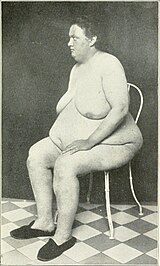Adiposogenital dystrophy
| Adiposogenital dystrophy | |
|---|---|
| Other names | Babiński-Fröhlich syndrome[1][2][3][4] (commonly associated with slipped capital femoral epiphysis),Froelich's syndrome, Fröhlich's Syndrome, Hypothalamic Infantilism-Obesity, Launois-Cleret Syndrome, Sexual Infantilism |
 | |
| Specialty | Endocrinology |
Adiposogenital dystrophy is a condition that may be caused by tertiary hypogonadism originating from decreased levels in GnRH. Low levels of GnRH has been associated with defects of the feeding centers of the hypothalamus[citation needed], leading to an increased consumption of food and thus caloric intake.
Presentation
[edit]It is characterized by:[citation needed]
- Obesity
- Growth delays and delayed sexual development, atrophy or hypoplasia of the gonads, and altered secondary sex characteristics,
- Headaches
- Problems with vision
- polyuria, polydipsia.
It is usually associated with tumors of the hypothalamus, causing increased appetite and depressed secretion of gonadotropin. It seems to affect males mostly.[citation needed]Many overweight children may appear to have the disorder because of the concurrence of obesity and retarded sexual development; these children have no endocrine disturbances, however, and they mature normally after delayed puberty.[citation needed]
Diagnosis
[edit]Laboratory analysis of the urine from children with Froehlich syndrome typically reveals low levels of pituitary hormones, and that finding may suggest the presence of a lesion on the pituitary. Additional tests are needed before a definite diagnosis of Froehlich syndrome may be made.[5]
Treatment
[edit]Pituitary extracts may be administered to replace the missing hormones (hormonal replacement therapy) in patients with Froehlich syndrome. Tumors of the hypothalamus should be surgically removed if possible. Appetite may be very difficult to manage, although weight control depends on this.[citation needed]
References
[edit]- ^ synd/1792 at Who Named It? - Babiński-Fröhlich syndrome
- ^ J. F. Babiński. Tumeur du corps pituitaire sans acromégalie et avec arrêt de développement des organes génitaux. Revue neurologique, Paris, 1900, 8: 531-535.
- ^ A. Fröhlich. Ein Fall von Tumor der Hypophysis cerebri ohne Akromegalie. Wiener klinische Rundschau, 1901, 15: 833-836; 906-908.
- ^ Zárate A, Saucedo R (2007). "[The adiposogenital distrophy or Fröhlich syndrome and the beginning of the concept of neuroendocrinology]". Gac Med Mex (in Spanish). 143 (4): 349–50. PMID 17969845.
- ^ "Froelich Syndrome".
